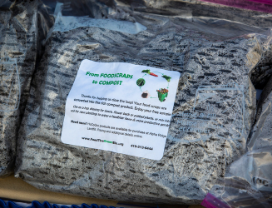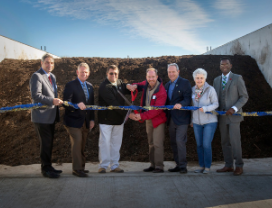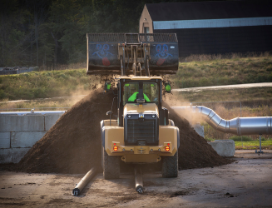About
The Bureau of Environmental Services has constructed the first part of a larger, long-term facility to produce quality compost.
The compostable material comes from residents and schools participating in our Feed The Green Bin program. This is supplemented by material directly hauled by residents and contractors to Alpha Ridge. The original pilot facility started accepting material in March 2013.
Ongoing construction to build compost processing facilities will ensure that the project meets all of the intent of the 2015 compost processing regulation implemented by Maryland Department of the Environment. We are working with State and County regulatory agencies and departments to ensure that the composting facility meets and exceeds environmental standards and expectations and creates high quality compost. We have created a successful composting program that protects the environment and serves as a model for other local communities.
Frequently Asked Questions
Why is the County doing this project?
The goal of this project is to compost yard trim and food scraps locally, saving on processing and transportation costs. Benefits include keeping the material local, reducing greenhouse gas emissions, and creating a beneficial soil amendment which reduces the need for chemical fertilizers, reduces erosion, and increases water retention in soils. Currently, this is the only facility of its kind in Maryland.
What types of materials are composted?
Materials include yard trim such as leaves, grass clippings and brush; food scraps such as fruits, vegetables, meat, dairy and baked goods generated by County residents and collected by the County as part of our Feed The Green Bin food scrap collection program.
What technology is being used?
The County is using a process manufactured and designed by Engineered Compost Systems. The AC Composter Aerated Static Pile system is a proven technology in wide use throughout the West Coast. A computer-controlled blower keeps the material saturated with oxygen, which accelerates decomposition and manages moisture levels. The cover system retains heat and high-nutrient materials while managing potential odors.
Can businesses drop off food scraps?
At this time, our Composting Facility can only accept food scraps and compostable material from County residents. Commercial food waste generators can contact Maryland Department of the Environment (MDE) for assistance.
Is HoCoGro organic?
There is no national standard for “Organic” compost. Our compost is manufactured / recycled from natural living materials and water, without the addition of any chemicals. The chemical properties of our compost vary slightly through the seasons as the inputs we receive vary. The properties of are compost are relatively consistent and are identified within the current laboratory analysis.
USDA’s National Organic Program (NOP) encourages the use of compost as a soil amendment to grow organic produce. NOP regulates organic produce and defines what produce can use the term “Organic”. Inputs such as water, fertilizers, pesticides and compost are regulated by these rules, which dictate how they are made and from what, but do not specify any rules by which inputs may be called “Organic.” Thus there is no national standard for “organic” compost.
HoCoGro Compost is great to use to grow produce, organically or traditionally. We gladly work with organic farms and their certifiers to meet any of their documentation needs.
Is the product for sale?
Yes. Mulch, Compost and a Topsoil Blend are available at the Wood Waste Area.
Will this produce odors or attract pests?
No. A Feedstock Receiving building is in place to grind, mix and store feedstock prior to placement in the Aerated Static Pile composting bunkers. This structure is covered and helps ensure odors are managed. An adjacent biofilter is used to treat collected moist air.
If Alpha Ridge has a Landfill Gas to Energy Generator--why separate out food scraps at all?
Because food scrap has a high moisture content and high nutritional value, it easily decomposes. That is the case whether it is in your refrigerator, the landfill or in our composting facility. When material decomposes in a landfill or other environments that have little or no air, decomposition is incomplete and methane is produced. Methane that finds its way into the atmosphere is a potent greenhouse gas, acting 25-80 times as strongly as carbon dioxide, ton for ton.
Most landfills are designed to remain open and accept waste for 10-30 years. Gas collection systems however are most often designed to be installed after the landfill is complete. That means food scrap and other wastes that easily decompose, will be partially or fully broken down long before the collection system is installed.
Woody materials such as lumber, paper towels, and cardboard, don’t break down so easily, and take much longer (decades) to decompose. These materials produce smaller quantities of methane for long periods of time.
Gas collection systems are not perfect. EPA models suggest that most landfills with gas collection systems only collect about 65%-80% of the methane produced. Air intrusion, inefficient caps, poorly placed wells, all contribute to fugitive methane going to the atmosphere. The best way to reduce the production of landfill gas is to put less stuff in landfills, especially organic materials.
What has been most challenging?
Contaminants and moisture. The exclusion of plastic yard trim bags has created a huge improvement to compost quality and reduction in waste. Litter at the site has been reduced significantly. However, many residents continue to include plastic garden waste in their yard trim which doesn't break down and in turn ends up as compost contamination. From a processing issue, dry compost gives the false sense of being finished and stabilized, only to reactivate when given moisture. The expanded facility and other equipment modifications have allowed us to better manage moisture.
Can I tour this facility?
Yes! We regularly schedule tours of the Composting Facility and our Residents' Convenience Center. Tours are typically scheduled Monday - Friday between 10 a.m. and 2 p.m. Use the link below to request a tour of either facility or both!


